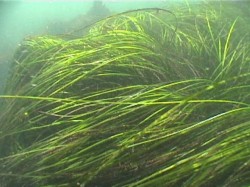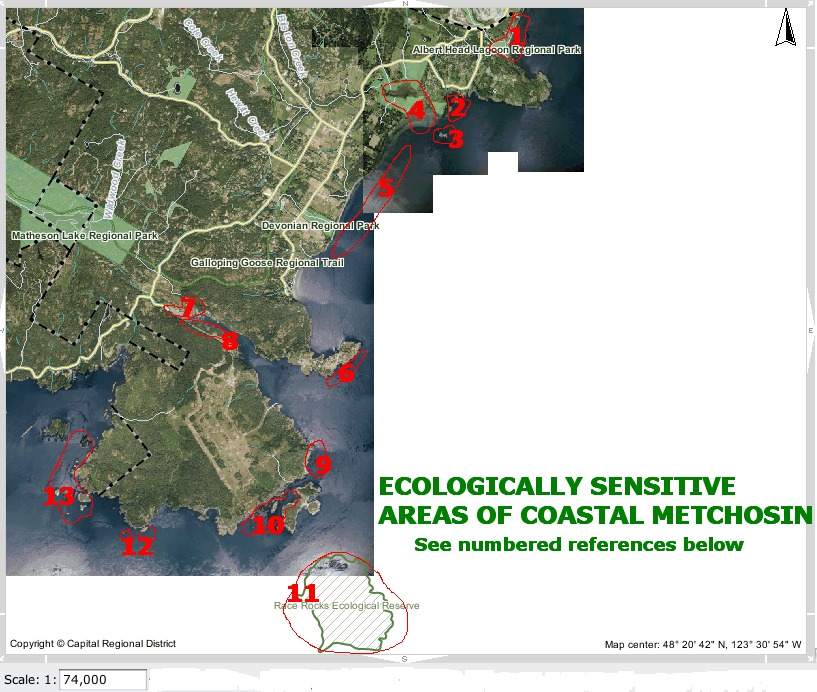There are several areas along Metchosin’s coastline where there are beds of the two species of sea grasses.
 Eelgrass : Zostera marina: http://www.racerocks.com/racerock/eco/taxalab/2006/zosteram/zosteram.htm
Eelgrass : Zostera marina: http://www.racerocks.com/racerock/eco/taxalab/2006/zosteram/zosteram.htm
See this map, for locations of eel grass meadows, at #5 (off Taylor Beach) and # 12, (behind Swordfish Island)
 Surf Grass: Phyllospadix scouleri : http://www.racerocks.com/racerock/eco/taxalab/phyllospadix.htm
Surf Grass: Phyllospadix scouleri : http://www.racerocks.com/racerock/eco/taxalab/phyllospadix.htm
Surf grass is most common on the West shore of Race Rocks (#11) and Church Island (#12)
The Coastline of Metchosin is not as protected as the inner shores of the Victoria to Sidney area. Eelgrass needs protection and thus is minimally important in our area as fish habitat compared to the macro-algal kelp beds.
The following reference details the work done on the mapping of sea grasses in other areas of lower Vancouver island:
From: Island Trust Fund E-News Update March 27, 2013
Why we are mapping eelgrass
Seagrasses form large meadows that serve as nursery habitat and a refuge for juvenile fishes. The leaves serve as a cornerstone for the marine food web, supplying nutrients to salmonids and other fish, shellfish, waterfowl and about 124 species of faunal invertebrates.
Eelgrass habitats within the Salish Sea provide the basis for the region’s commercial and recreational fisheries revenue. The productivity of native seagrasses rivals the world’s richest rainforests.Eelgrass habitats capture and store large amounts of carbon at much more efficient rates than terrestrial forests. Scientists estimate the salt marshes and seagrass meadows of B.C. sequester the equivalent of the emissions of some 200,000 passenger cars.
Contaminates and shoreline development put pressure on fragile eelgrass meadow ecosystems. To protect eelgrass, we need to know where it is. We’re mapping eelgrass habitat so that we can better plan our strategies to conserve these valuable underwater ecosystems
The Islands Trust Fund is mapping nearshore eelgrass habitat in the Strait of Georgia and Howe Sound, in partnership with SeaChange Marine Conservation Society and the Seagrass Conservation Working Group.
Eelgrass Mapping Completed
- Gambier Island
- Lasqueti Island (east)
- Lasqueti Island (west)
- Mayne Island
- North Pender Island
- South Pender Island
- Thetis and associated islands (except Valdes)
Additional Technical Reference :
Mapping of Eelgrass (Zostera marina) at Sidney Spit Marine Park, Gulf Islands National Park Reserve Using High Spatial Resolution Remote Imagery: by Jennifer D. O’Neill BSc, University of Victoria, 2006:
ABSTRACT: The main goal of this thesis was to evaluate the use of high spatial remote imagery to map the location and biophysical parameters of eelgrass at Sidney Spit Marine Park, part of the Gulf Islands National Park Reserve. To meet this goal, three objectives were addressed: (1) Define key spectral variables which provide optimum separation between eelgrass and its associated benthic substrates, using in situ hyperspectral measurements, and simulated IKONOS and Landsat 7ETM+ spectral response; (2) evaluate the efficacy of these key variables in classification of the high spatial resolution imagery, AISA and IKONOS, at various levels of processing, to determine the processing methodology which offers the highest eelgrass mapping accuracy; and (3) evaluate the potential of ―value-added classification of two eelgrass biophysical indicators, LAI and epiphyte type.

